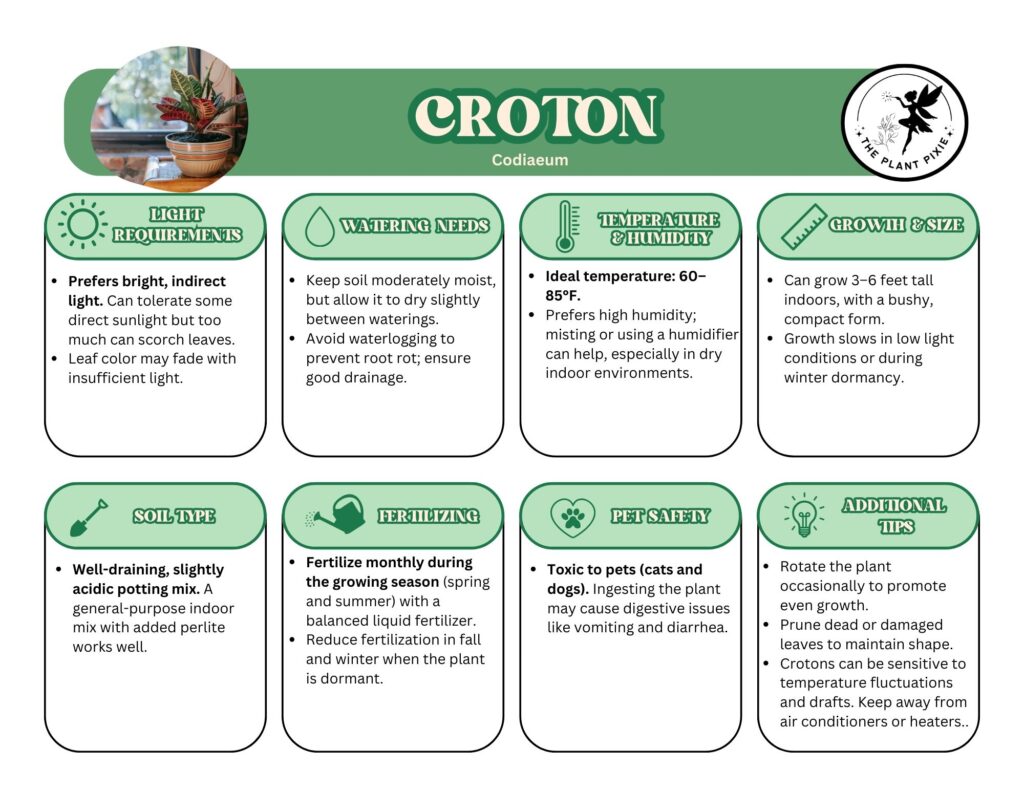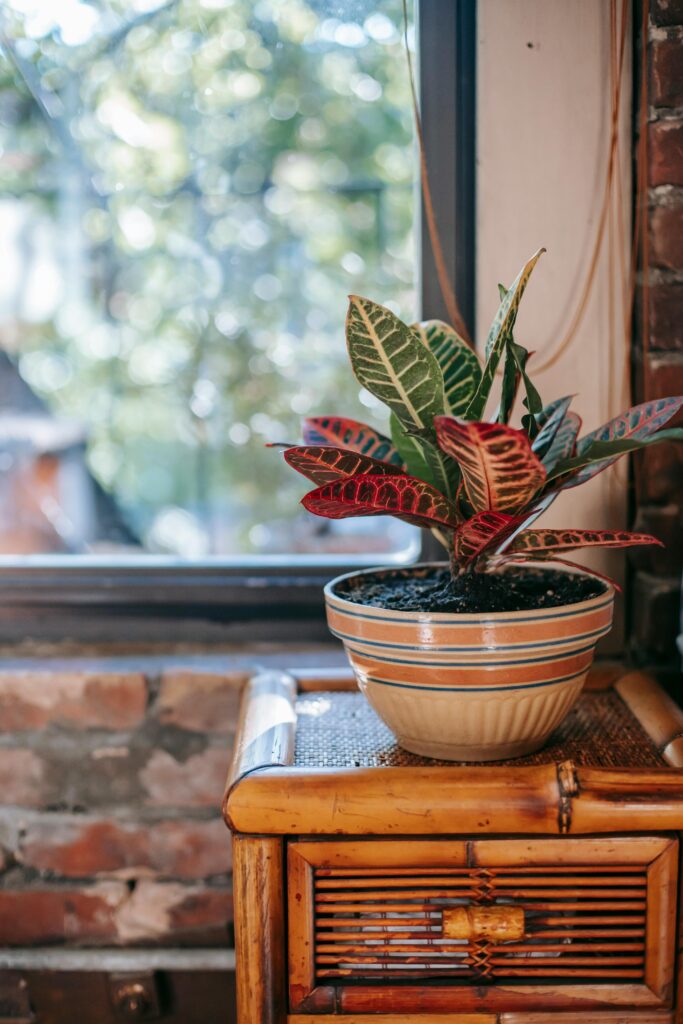
1. Botanical Overview:

- Family and Species:
- Codiaeum belongs to the Euphorbiaceae family, which includes a wide variety of plants, many of which are ornamental.
- The genus Codiaeum contains about 20 species, with Codiaeum variegatum being the most commonly cultivated variety.
- Plant Characteristics:
- Features bold, glossy, leathery leaves with striking color patterns and shapes.
- Growth habit: Upright, bushy plant that can be grown as a shrub or small tree.
- Leaves can vary in shape (lance-like, oval, or curly), with unique color variations that intensify with proper care.
2. Ideal Growing Conditions:
- Light:
- Prefers bright, indirect sunlight but can tolerate some direct sunlight for a few hours a day.
- Inadequate light can lead to leggy growth and a loss of vibrant leaf colors.
- Ideal for placement near east or west-facing windows with access to filtered sunlight.
- Temperature:
- Thrives in warm temperatures between 60°F–85°F (15°C–29°C).
- Sensitive to drafts and cold temperatures; protect from temperatures below 50°F (10°C).
- Humidity:
- Prefers high humidity (50% or more) but can tolerate average indoor humidity.
- In dry environments, consider using a humidifier or misting the leaves to prevent leaf curl and brown edges.
- Soil:
- Requires well-draining, fertile soil that retains moisture but does not become waterlogged.
- A standard potting mix combined with perlite works well for improving drainage.
- Slightly acidic to neutral soil (pH 6.0–7.0) is ideal for optimal growth.
3. Watering Croton:
- Watering Basics:
- Keep the soil consistently moist, but not soggy. Water when the top inch of soil feels dry to the touch.
- Water thoroughly until it drains from the bottom of the pot, ensuring even moisture distribution.
- Signs of Overwatering:
- Yellowing or dropping leaves, mushy stems, or a musty smell from the soil.
- Root rot can occur from waterlogged soil, so ensure good drainage and avoid leaving the plant in standing water.
- Signs of Underwatering:
- Dry, crispy leaf edges, wilting leaves, and overall poor growth.
- Crotons can be quite sensitive to underwatering, and prolonged dryness can lead to the loss of vibrant color.
- Watering Tips:
- Use room-temperature water and ensure the plant is never sitting in water after watering.
- Avoid letting the plant dry out completely for extended periods of time, especially in warmer months.
4. Fertilizing Croton:
- When to Fertilize:
- Fertilize during the growing season (spring and summer) every 4-6 weeks.
- Reduce or stop fertilizing during the dormant period (fall and winter) when the plant is not actively growing.
- Type of Fertilizer:
- Use a balanced, water-soluble fertilizer (e.g., 10-10-10) diluted to half strength.
- Alternatively, you can use a liquid fertilizer designed for flowering houseplants or tropical plants.
- How to Fertilize:
- Apply fertilizer to moist soil to prevent root burn.
- Avoid applying fertilizer to dry soil or directly onto the plant’s leaves.
- Signs of Over-Fertilizing:
- Yellowing or browning leaf tips, excessive leggy growth, or salt buildup on the surface of the soil.
- Signs of Under-Fertilizing:
- Slow or stunted growth, lack of new leaves, and pale or washed-out leaf colors.
5. Common Issues and How to Solve Them:
- Yellowing or Drooping Leaves:
- Causes: Overwatering, underwatering, or nutrient deficiencies.
- Solutions: Adjust watering habits, check for root rot, and ensure the plant receives enough light and nutrients.
- Browning Leaf Edges:
- Causes: Low humidity, underwatering, or over-fertilizing.
- Solutions: Increase humidity, water consistently, and avoid using excessive fertilizer.
- Leaf Drop:
- Causes: Stress from sudden environmental changes (e.g., temperature fluctuations, draft, or too much direct sun).
- Solutions: Keep the plant in a stable environment with consistent temperature and light.
- Leggy Growth:
- Causes: Insufficient light or overcrowding.
- Solutions: Provide brighter light, especially during the winter months, and prune leggy stems to encourage bushier growth.
- Pests:
- Common pests: Spider mites, mealybugs, aphids, and scale.
- Solutions: Regularly inspect the plant for pests, remove pests by wiping the leaves with a damp cloth, and treat infestations with neem oil or insecticidal soap.
6. Pruning and Maintenance:
- Why Prune Codiaeum?
- Pruning helps to maintain the plant’s shape, remove dead or damaged leaves, and encourage bushier growth.
- Regular pruning also improves airflow, reducing the risk of fungal infections.
- When to Prune:
- Prune during the growing season (spring and summer) when the plant is actively producing new growth.
- Remove any leggy or dead stems to keep the plant looking full and healthy.
- How to Prune:
- Use clean, sharp scissors or pruning shears to cut back overgrown stems and damaged leaves.
- Trim back at the base to encourage branching or to shape the plant into a more compact form.
- Maintaining Shape:
- Pinch back new growth to encourage a fuller, bushier appearance.
- Remove older, less vibrant leaves to make room for new, colorful growth.
7. Repotting Croton:
- When to Repot:
- Repot every 1-2 years or when the plant has outgrown its current pot or becomes root-bound.
- Signs it’s time to repot include slowed growth, roots growing out of drainage holes, or the soil drying out too quickly after watering.
- Best Potting Tips:
- Choose a pot 1-2 inches larger in diameter than the current one, with good drainage.
- Use a rich, well-draining potting mix, such as one designed for tropical plants or houseplants.
- Repotting Steps:
- Gently remove the plant from the pot, shaking off excess soil around the roots.
- Trim any damaged or excessively long roots before placing the plant in its new container.
- Add fresh potting mix around the roots and water lightly after repotting.
8. Propagation of Croton:
- How to Propagate:
- Codiaeum is typically propagated through stem cuttings.
- Cut a healthy stem with at least 2-3 nodes and place it in water or directly into moist soil until roots develop.
- Propagation Tips:
- Use a sharp, clean knife or scissors to make a clean cut.
- Place the cutting in a warm, bright location (indirect light) to encourage rooting.
- Keep the soil or water consistently moist, and be patient as roots develop (usually within 2-3 weeks).
- Propagation Success:
- Propagation success is higher in the warmer months (spring and summer).
- Once the cutting has rooted, it can be repotted into soil and treated as a mature plant.
9. Benefits of Owning Croton:
- Aesthetic Appeal:
- Crotons are prized for their colorful and dramatic foliage, making them an excellent focal point in any room.
- The plant’s striking colors and patterns add a vibrant touch to any decor, particularly in living rooms, offices, and entryways.
- Low Maintenance:
- Despite its flashy appearance, Codiaeum is relatively easy to care for once you understand its basic light, water, and humidity needs.
- Air Purification:
- Like many houseplants, Croton helps purify indoor air by absorbing carbon dioxide and releasing oxygen.
10. Fun Facts About Croton:
- Name Origin: The name Codiaeum comes from the Greek word kodiaios, meaning “head” or “cap,” referring to the plant’s crown-like appearance.
- Symbolism: In some cultures, Croton is believed to symbolize good fortune, prosperity, and protection.
- Historical Significance: Croton has been cultivated for centuries and was used in tropical gardens and ornamental landscaping long before it became a popular houseplant.
Featured image credit: Mokkie, CC BY-SA 3.0 https://creativecommons.org/licenses/by-sa/3.0, via Wikimedia Commons

